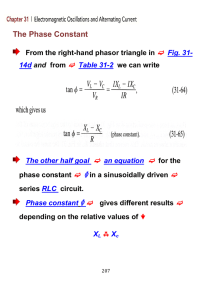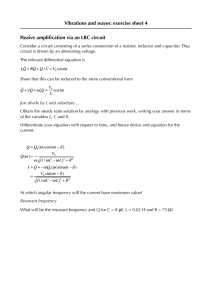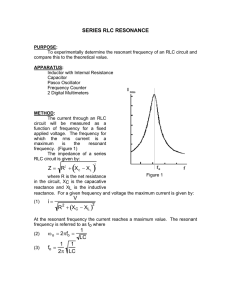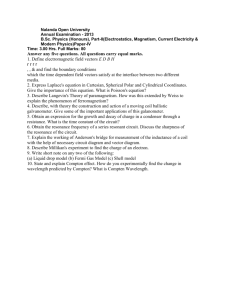Resonance - Electrical and Computer Engineering
advertisement
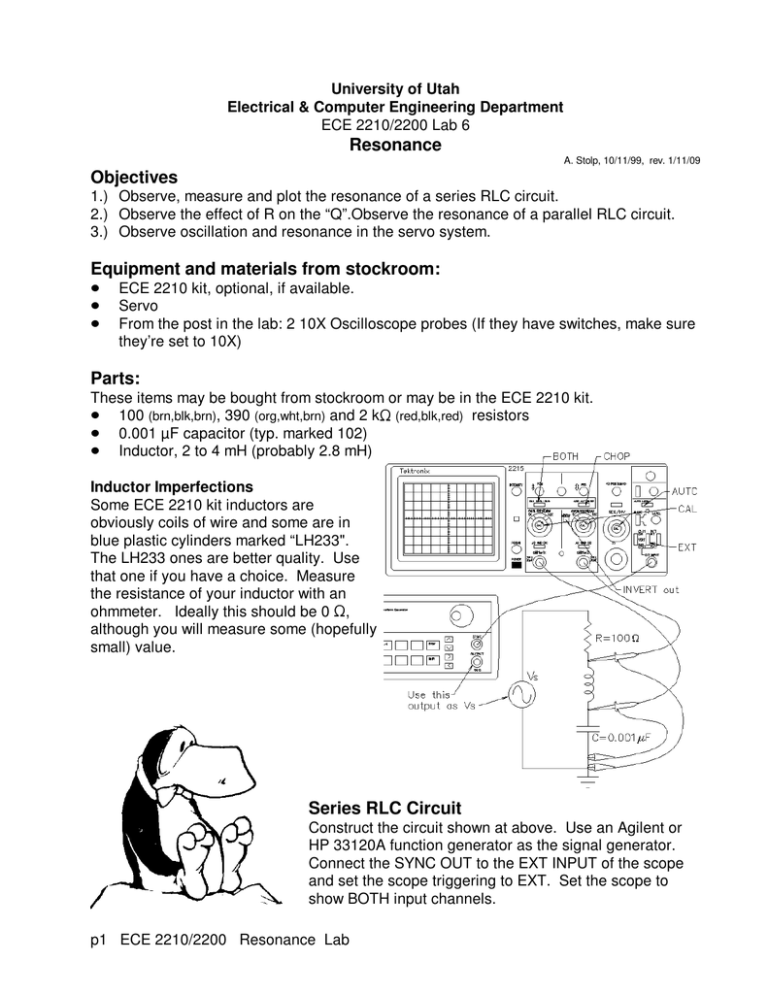
University of Utah Electrical & Computer Engineering Department ECE 2210/2200 Lab 6 Resonance Objectives A. Stolp, 10/11/99, rev. 1/11/09 1.) Observe, measure and plot the resonance of a series RLC circuit. 2.) Observe the effect of R on the “Q”.Observe the resonance of a parallel RLC circuit. 3.) Observe oscillation and resonance in the servo system. Equipment and materials from stockroom: ECE 2210 kit, optional, if available. Servo From the post in the lab: 2 10X Oscilloscope probes (If they have switches, make sure they’re set to 10X) Parts: These items may be bought from stockroom or may be in the ECE 2210 kit. 100 (brn,blk,brn), 390 (org,wht,brn) and 2 k (red,blk,red) resistors 0.001 µF capacitor (typ. marked 102) Inductor, 2 to 4 mH (probably 2.8 mH) Inductor Imperfections Some ECE 2210 kit inductors are obviously coils of wire and some are in blue plastic cylinders marked “LH233". The LH233 ones are better quality. Use that one if you have a choice. Measure the resistance of your inductor with an ohmmeter. Ideally this should be 0 , although you will measure some (hopefully small) value. Series RLC Circuit Construct the circuit shown at above. Use an Agilent or HP 33120A function generator as the signal generator. Connect the SYNC OUT to the EXT INPUT of the scope and set the scope triggering to EXT. Set the scope to show BOTH input channels. p1 ECE 2210/2200 Resonance Lab Find resonance: Compute the resonant frequency (fo in Hz or kHz) of your capacitor and inductor combination (calculated value). Set the function generator to this frequency. Now vary the frequency up and down while looking at vc on the scope. The frequency where vc is at its maximum is the actual resonant frequency (fo) of your circuit. This can be a little tricky to find with the 33120A because the knob adjusts one digit at a time. To find the true maximum, use the right-arrow button to adjust the lower digits. When you find the frequency where vc is greatest, record the frequency shown on the function-generator. Compare the actual fo to your calculated fo value. Plot freq. response: Take enough measurements of the CH1 and CH2 voltages to plot them both as a function of frequency from fo/8 to 8fo. Generally, when a value is plotted as a function of frequency, the frequency is plotted on a log scale, it makes your curves look much more symmetric. You may have done this before by plotting 100Hz, 300Hz, 1kHz, 3kHz,... measurements on an evenly divided scale. Another simple way to do this is to take and plot your measurements by factors of two. Divide your horizontal axis into six divisions (seven marks). Label the center mark with the nearest whole number to fo. Double the frequency for each mark to the right and halve the frequency for each mark to the left. This way the leftmost mark will be about fo/8 and the right-most will be about 8fo. Wah-lah.., A simple log scale. Move CH2 of the scope to measure vs (other side of the resistor). Tune your circuit to fo. Find the ratio of vc/vs. How can this be greater than 1? Explain. Phases: Adjust the function generator up and down around the resonant frequency while you observe the phase relationship between the two traces. Explain or sketch what you see. Explain why this makes sense. Think in terms of the inductor and capacitor impedances. Which one dominates above the resonant frequency and which one dominates below the resonant frequency? The dominant one will determine the phase of the current in the circuit. Different resistor: Replace the 100 resistor with a 390 resistor. Connect CH2 of the scope back to where it was. Take measurements to make the same type of plots as you made before. You may want to plot these on the same horizontal axis, but be sure that all your plotted lines are clearly labeled. Q: Resonant circuits are also characterized by a factor known as the “quality" or “Q” of the circuit. The higher the Q value the sharper the resonant peaks and valleys. Judging by your plots, which of your two circuits has the higher Q? Usually the Q is inversely related to the resistance it the circuit. Comment in your notebook. p2 ECE 2210/2200 Resonance Lab Parallel RLC Circuit Construct the circuit shown at right, using the same components. Experimentally find the resonant frequency (fo) of this circuit. Is it the same as that of the series circuit? How is resonance different in this circuit? Reset the scope triggering from EXT to INT. Oscillation and Resonance of the Servo Turn off the power switch on the servo and hook it up to the power supply. Adjust the power supply to provide + 6V as you did in the first lab. If you’ve forgotten how to do this, refer back to the lab handout for lab 1. Turn on the power switch on the servo and make sure that it is functioning properly. Remember, to comment in your lab notebook that you hooked power to the servo and made sure it was still working. Hook the scope probe ground clip to the servo ground. Remember the green wire about 1.5 inches to the left of the switch connects the ground rows of the breadboard. (For more info look back at the Thévenin Lab.) Hook the scope probe up to the center wire of the “Motor Position Sensor” potentiometer (brown wire). Remark in your notebook that you hooked the scope up to the “Motor Position” signal. Set the “Input Position” potentiometer to about center position. Turn up the “Gain” (CW) as far as it will go. If the servo doesn’t begin to oscillate on its own, make a slight adjustment to the “Input Position” potentiometer and it should start. Describe what is happening in your notebook. Adjust the scope to get a repeating trace. If you can’t stabilize the trace, try turning up the “HOLDOFF” or switch the triggering to “NORM” and adjust the “LEVEL” control. If you are using the 2210 scope, you may want to try the storage feature. Find the period and frequency of oscillation. Now slowly turn down the gain until the oscillations stop. Leave the gain at this “barely stable” position. Hook a BNC-to-BNC cable from the function generator to the servo “SIGNAL” input. Turn on the function generator and adjust the amplitude to show 500mVpp (actual output will be 1Vpp). Listen to the servo motor. Is it trying to move back and forth 1000 times per second? It’s not moving very far, is it? Why can’t the mechanical system keep up? Turn down the frequency until you get significant movement. Adjust the function generator mVpp to a lower value, say 200mVpp. Lower the frequency farther and try to find a resonance. (You may have to lower the mVpp again to keep the scope trace looking decent. Find the resonant frequency of the servo (where the output is the greatest). Be careful , there may be more than one peak. This seems to be caused by strange dynamics of the rubber link between the mechanics and the “Motor Position Sensor”. Make sure that p3 ECE 2210/2200 Resonance Lab you are on the are biggest peak for true resonance. How does this frequency compare to the natural oscillation frequency that you found earlier? It should be pretty close (but I have to admit, the servos are not very accurate and few people get this resonance to mach the oscillation frequency). Conclude As always, check off and write a conclusion. p4 ECE 2210/2200 Resonance Lab
